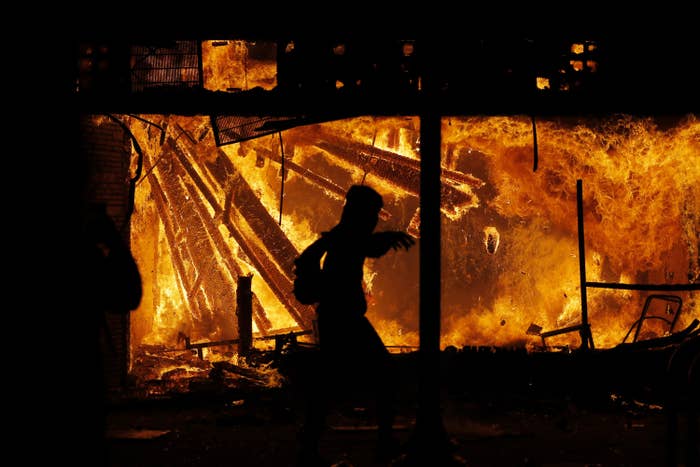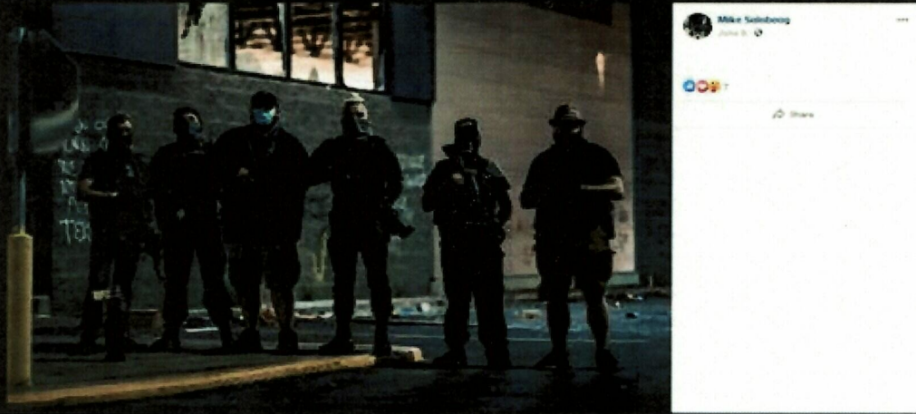
The young man came to the protest over the police killing of George Floyd wearing a tactical vest on his chest and a skull mask over his face. In grainy video footage captured outside of Minneapolis’s 3rd Police Precinct on the night of May 28, the man can be seen pulling out an AK-47 style rifle and blasting 13 shots into the police building. The shooting happened shortly before the structure was set ablaze.
On Friday, federal officials issued a complaint against a 26-year-old Texan, Ivan Harrison Hunter, they say they have identified as the man in the video. Hunter faces one count of participating in a riot, with a sentence of up to five years in prison.
Hunter could not be reached for comment, and it was not immediately clear whether he had a lawyer.
But along with the charge, federal officials unsealed an affidavit accusing Hunter of being part of a loose nationwide network of violent extremists, known as "boogaloo" boys (also spelled "bois"). The extremists connected and communicated through social media apps, including Facebook, to plot and glorify shocking violence, including killing a federal officer in Oakland and a scheme to supply Hamas with weapons to use against US soldiers.
For example, just a few hours after allegedly shooting up the precinct, Hunter messaged an associate in California, Steven Carrillo.
“Boog,” Hunter wrote.
“Did,” Carrillo responded.
“Go for police buildings,” Hunter advised.
“I did better lol,” Carrillo answered. Indeed, shortly before that exchange, according to authorities, Carrillo had shot and killed a Federal Protective Service officer, David Patrick Underwood, in Oakland.
Experts said the affidavit suggests evidence of a development that many have long suspected and feared: The so-called boogaloo boys may not be just disconnected extremists who share a penchant for Hawaiian shirts and chaos. They may have built nationwide systems to coordinate acts of violence and terror.

“This now tells us the Boogaloo Bois are more than just a bunch of unconnected extremists,” said Brian Levin, director for the Center for the Study of Hate and Extremism at California State University, San Bernardino. “[It’s] a network for extremists who communicate in real time around terror plots and attacks.”
According to the Southern Poverty Law Center, the boogaloo boys emerged from “antigovernment and white power online spaces in the early 2010s.” They have at times called for a second Civil War and are well known for wearing floral Hawaiian shirts with camouflage fatigues and subscribing to a range of extremist ideas.
The criminal complaint filed in court Friday reveals a network across the country whose members have been directly linked with deadly acts, hoping to incite even more violence across the nation. It also reveals the violent group of extremists used a variety of apps to communicate and network, yet continued to heavily rely on Facebook to not just connect with one another, but amplify their message over a network that expanded across the country, touching on Oakland, Minneapolis, Texas, and across to North Carolina.
Facebook announced on June 30 that it was banning the anti-government network from its platform. BuzzFeed News had previously reported that the social network had profited by running ads for boogaloo pages.
Despite the ban, Levin said much damage had already been done: The group had already greatly expanded using the network. Now, groups like the boogaloo boys could simply move their network out of Facebook and into other encrypted apps and networks.
“The problem is they give the vaccine after the virus has already ravaged the body,” Levin said of the decision by Facebook to ban boogaloo groups on its platform. “The horses are out of the barn now with regard to boogaloo.”

According to court records, it was a May 26 Facebook post that prompted Hunter to drop everything, grab his AK-47-style rifle and make the 1,000-mile drive from Austin to Minneapolis, where protests over the killing of George Floyd by police had turned violent.
“I need a headcount,” the post read, asking boogaloo boys members across the country to respond.
“72 hours out,” Hunter replied.
The Facebook post Hunter responded to, authorities said, was posted by Michael Solomon, a 30-year-old who, along with Benjamin Ryan Teeter, is accused of trying to sell weapons to someone they believed was a member of Hamas. The two also considered becoming “mercenaries” for the terrorist group, prosecutors alleged, in order to raise money to fund the boogaloo movement.
“Lock and load boys,” Teeter allegedly posted on Facebook as he headed to Minneapolis from North Carolina. “Boog flags are in the air, and the national network is going off.”
As each man made their separate drives to Minneapolis, federal officials allege that Teeter and Hunter communicated mostly through Facebook messages, and coordinated with Solomon to eventually meet at a Cub Foods grocery store near the police department’s third precinct.
“We have a team of 5,” Hunter messaged Solomon, according to the indictment.
Video obtained by the FBI shows someone wearing a skull mask over his head, glasses, and a baseball cap firing into the police station that night while looters were inside the building. According to the indictment, Hunter was identified as the shooter by a “cooperating defendant.”
Hunter allegedly yelled out “Justice for Floyd!” and then high-fived someone nearby.
Days later, Solomon would post a picture on his Facebook page of the group standing in the darkness outside the Cub Foods that day, including Hunter holding on to his rifle.
Teeter would post two pictures with Hunter, wearing the same skull mask, and then message him calling themselves “battle buddies” before Hunter headed back down to Texas.
“My mom would call the fbi if she knew what I do and the level I’m at w[ith] iot,” Hunter allegedly wrote on social media.
The group of extremists continued to communicate through Facebook and other apps, and even reached out to each other as law enforcement tried to catch up to them.

On June 1, Carrillo was being sought by law enforcement after allegedly killing a federal officer in Oakland. Officials said Carrillo is believed to have taken advantage of the massive protests that erupted across the country “to kill cops” to try to spark a civil war.
Carrillo was in hiding when Hunter reached out on Facebook again, asking for money.
Court records don’t explain why Hunter needed the money, but Carrillo responded that he was going to “be in the woods for a bit,” and managed to send Hunter $200.
“Doing good shit out there,” Carrillo allegedly wrote to Hunter.
“You too king!” he replied.

Meanwhile, on Facebook, Hunter publicly boasted of committing violent acts, claiming he had “burned police stations with black panthers in Minneapolis.”
“Want something to change? Start risking felonies for what is good,” he wrote.
According to the complaint, Hunter referred to himself as a “terrorist,” and claimed he and Carrillo were members of the “Happy Friends Group,” a team that would respond with violence if police tried to take their guns away.
Then on June 7, Hunter learned Carrillo had been taken into custody, accused of shooting and killing a Santa Cruz sheriff’s deputy in the process. Before officers grabbed him, Carrillo allegedly wrote “BOOG” on the hood of a white van with his own blood.
Hunter sent a Facebook message to Teeter that day, sharing a link to news of the arrest.
“Well shit,” Teeter replied.
It was months later in September that Hunter would learn that Teeter and Solomon were arrested over their alleged plot to sell weapons to Hamas.
The 26-year-old then told a confidential informant working with the FBI that it was “time to start shooting” and that he was willing to “go down shooting.”
